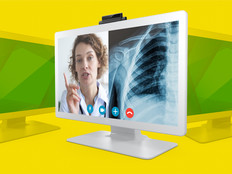Transforming the Patient Experience Through “Smart Room” Technologies
Today’s technologies consolidate critical resources targeted at patients across the continuum of care. This vision for patient-centric technology extends across hospital systems and, truly, all healthcare organizations that make up the patient care community.
One way to make this vision a reality is to concentrate on the technologies used in patient rooms in order to measurably improve the patient experience before, during and after a stay. Effectively, this means transforming patient rooms into “smart rooms” that take technology utilization to that next level. This transformation has already begun, and we anticipate it to grow in the coming years.
DOWNLOAD: Check out how next-generation engagement tech enhances patient outcomes.
What Can Smart Hospitals Deliver to Patients?
What does it mean to create smart spaces in healthcare? It means leveraging technologies, such as Internet of Things devices, tablets, smartphones, smart TVs and more, both inside and outside the walls of the hospital, in order to deliver care and resources to the patient at any time in a care journey.
But it also means thinking differently about patient care; being proactive versus reactive in how hospitals “see” a patient. Patients’ healthcare journeys do not begin and end within the four walls of their hospital rooms or last for only the amount of time they are there. They had a rich healthcare history well before their admission and have a healthcare future that extends beyond the moment of discharge.
It’s time to leverage technology and information in smarter, more meaningful ways to better engage patients and transform their expectations when it comes to their experience. How do healthcare organizations embrace patients before they even arrive? And how do they more thoughtfully engage patients during and after their stay?
Patient Empowerment Tools Prove Key to Satisfaction
It begins with leveraging technology to access patient records. The right tools at the patient’s side can help physicians and clinicians get a clearer picture of patient history, current needs and discussion points to make each interaction more productive and less taxing on patients.
But access to patient records is just the beginning. Patients themselves must also be able to use technology to access educational content and in-room entertainment. The days of five-channel TVs with rabbit ears mounted on a wall are quickly disappearing. Flat-screen monitors that are tied to hospital networks and to devices within the patient room are becoming the norm. This technology can inform the patient and authorized care team members about the patient’s health while in the hospital, and it can prepare the patient to better adhere to care plans prescribed at discharge.
Tablets provide even greater flexibility. Patients access cable, internet and mobile apps on hospital-provided tablets to help them relax and take their mind off their illness.
Tablets Let Providers and Patients Visualize the Future of Care
Let’s say a patient receives a tablet from the hospital that interfaces with the flat-screen TV. Both the patient and physician can call up information on their respective tablets and share it on the TV screen or between tablets.
Then, let’s say the patient can use the tablet to access educational materials about their illness, surgical procedure and discharge/aftercare instructions, all to prepare for what the coming days and weeks will entail. That’s a better experience so far, right?
But then, let’s say the patient can take that same tablet home to help monitor their condition post-discharge, ask questions of their care team and further read up on recovery instructions. Now the tablet has become a care platform (inclusive of virtual care features) that supports the ongoing nature of the patient’s healthcare journey. This would be the best possible patient experience scenario: leveraging smart room technology outside of hospital confines to help a patient achieve a more successful transition back into daily living and to help reduce their chance of readmittance.
This scenario only scratches the surface of the potential IT has to transform the quality, speed, accuracy and experience of patient care. As telehealth, mHealth and other leading-edge technologies evolve further, so will innovation at all points on the care continuum.
But transformation takes time. It doesn’t happen overnight. Some reading this will say, “We’re already doing this.” Others will think, “How will we ever do this?” The key is to be aware of the changing landscape from patient engagement to patient empowerment and to recognize how this transition is unfolding as the market itself transforms from encounter-based care to value-based care models.









